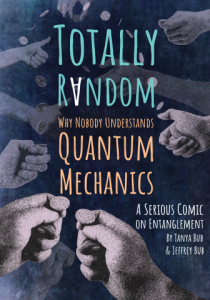 Totally Random is a comic for the serious reader who wants to really understand the central mystery of quantum mechanics--entanglement: what it is, what it means, and what you can do with it.
Totally Random is a comic for the serious reader who wants to really understand the central mystery of quantum mechanics--entanglement: what it is, what it means, and what you can do with it.
Measure two entangled particles separately, and the outcomes are totally random. But compare the outcomes, and the particles seem as if they are instantaneously influencing each other at a distance―even if they are light-years apart. This, in a nutshell, is entanglement, and if it seems weird, then this book is for you. Totally Random is a graphic experiential narrative that unpacks the deep and insidious significance of the curious correlation between entangled particles to deliver a gut-feel glimpse of a world that is not what it seems. See for yourself how entanglement has led some of the greatest thinkers of our time to talk about crazy-sounding stuff like faster-than-light signaling, many worlds, and cats that are both dead and alive. Find out why it remains one of science's most paradigm-shaking discoveries. Join Niels Bohr's therapy session with the likes of Einstein, Schrödinger, and other luminaries and let go of your commonsense notion of how the world works. Use your new understanding of entanglement to do the seemingly impossible, like beat the odds in the quantum casino, or quantum encrypt a message to evade the Sphinx's all-seeing eye. But look out, or you might just get teleported back to the beginning of the book!
A fresh and subversive look at our quantum world with some seriously funny stuff, Totally Random delivers a real understanding of entanglement that will completely change the way you think about the nature of physical reality.
A Totally Random Interview with Jeff & Tanya
Why a quantum comic?
TB: The idea came to us when we were working on an illustration for a somewhat tricky section of Jeff's last book, Bananaworld: Quantum Mechanics for Primates. What we wanted was for readers to have that "Aha!" moment of understanding when you experience something directly. Wouldn't it be cool if instead of just telling you about how weird quantum mechanics is, we could somehow hand you an object that has all the weirdness of quantum entanglement baked into it, so that you get to play with it and see for yourself. We agreed that would be great, but how? That's when we came up with idea of crafting a quantum object and making it "real" in the form of an experiential comic. The first strip was rough but we could sense that the feeling of understanding you got from it was really different and had a lot of potential. So we started to play around with the idea of doing a full-length quantum comic as a totally new way of giving people a direct understanding of what's so puzzling and fascinating about quantum mechanics.
Sounds great but can a comic really get across such a difficult topic?
JB: When you think about it, the early guys like Bohr, Einstein, Heisenberg, Schrödinger didn't read about quantum mechanics, not initially anyway. They were looking at the results of experiments and trying to imagine a reality that could explain what they were seeing. The comic more or less puts you in their shoes. Yes, the object you get to play with is simpler than what they had to deal with, but mostly all we do is remove any distracting noise that's not relevant to the mystery of entanglement, which Schrödinger recognized as "the characteristic trait of quantum mechanics, the one that enforces its entire departure from classical lines of thought." So the reader gets to personally see how all the crazy stuff they came up with like dead and alive cats, many worlds, apparent faster-than-light signaling, and so on, just sort of naturally falls out of the thing you are "holding" in your hands. We wanted people to experience that same feeling of having the rug pulled out from under their understanding of how the world works that Einstein, Bohr, and others had when they were first faced with quantum phenomena. There's a very fundamental and disturbing challenge to your commonsense picture of reality when you see how something that seems self-evident can turn out to be wrong.
What's with the hands?
TB: Ah yes, the hands! So, the whole idea behind the book is to drag you into the puzzle of entanglement, right? We don't know what you look like or who you are but we know that if you're reading the book your hands are holding it. So we thought, what if we actually draw you, your hands, into the book and make you one of the main characters. Because in the end you're the one that has to figure things out and you're the one that has to grapple with the questions and ideas that continue to trouble physicists and philosophers to this day.
The other characters in the book, J and T, are obviously you, Jeff and Tanya, the two authors. Are the characters true to life and does their relationship reflect your father/daughter relationship?
JB: I don't know what your relationship is with your parents or kids but imagine if you tried to write a book with one of them. You start to get a picture. There's this relationship, this connection that is necessarily going to be a part of the process. It's there, and what you want to do is use it to fuel the creative process, but you also can't let it get out of control.
TB: To be honest, the writing of this book included shouting matches as well as huge laughs and in the end it was those things that made it so intense and so much fun. Anyway, because the book asks you, the reader, to be present, we felt it was only fair to really be in there ourselves in some genuine way that reflected our own process in wrestling with these questions. So yes, while J and T are caricatures, they are in some sense real, and they capture the essence of our relationship and the experience of writing the book.
You also have historical characters like Einstein, Bohr and Schrödinger in the book. How do they fit in?
TB: OK, so you've been playing with your designer quantum object, which as you know is a pair of entangled coins, and you are convinced that something is terribly strange about them and you now have all these questions buzzing though your head. That's when "Einstein" comes along. He's the first physicist you encounter. He takes a look at your coins and in his own words tells you what he thinks of them. Exactly why he finds them so very interesting and troubling. And by "in his own words" what I mean is direct quotes taken from some of his most well-known papers as well as his correspondence with other physicists, but tweaked so that his words apply precisely to your coins, the entangled coins with which you are now intimately familiar. So in the course of the book you get to understand the subtle thinking of some of the greatest minds in physics, Einstein, Bohr, Schrödinger, Everett, Von Neumann, about quantum mechanics, in their own words, but applied to something that you grasp in both the literal and figurative sense.
Einstein is represented as a delivery truck driver, Bohr is a Freudian therapist, Von Neumann is a private eye. What was the thinking behind that?
TB: We really wanted to avoid the trap of having talking-head characters with long monologues. We felt that in order for the book to work we needed to take advantage of what comics are good at. Comics can put you in a place, give you an experience, have action, be funny, be outrageous. We really wanted our book to play on the strengths of the medium. So we gave each character a personality and job that somehow reflected the essence of their approach to quantum theory. Einstein as the blue-collar delivery truck driver brings the message of commonsense reasoning to the debate. Von Neumann as the private eye believes that a witness is required to close the case. Bohr uses psychotherapy to help you let go of your preconceived ideas about reality.
Does the book relate to modern-day thinking and technologies?
JB: Yes! You've probably seen stuff in the news about quantum technologies. We took the top three hot topics, quantum cryptography, quantum computing, and quantum teleportation and presented them in terms of three challenges that you have to solve using your wits and your entangled coins. By the end of this section you'll have a personal understanding of how quantum entanglement can be used to do stuff that is otherwise impossible, since you will have just done it yourself. It's quite funny too.
Who is this book for? Can someone with no background in quantum mechanics understand it, or is it for people who already know something about the subject?
TB: So, there's no math at all in the book and in that sense anyone can pick it up. No previous knowledge required. In fact one of our favorite reader comments came from a 13 year old girl called Nova who had no experience with the subject but was totally sucked into the puzzle of entanglement by way of the coins. My 12 year old son Arlo, one of my best early test readers, suggested making a change in in the quantum cryptography section that regularly stumps PhD readers. So, really, there are no prerequisites other than being curious and open minded. But the book will challenge some of your very fundamental ideas about how the world works. In other words, it really makes you think. If you are looking to shake up your perception of reality and you are willing to actively participate in the puzzles of quantum entanglement then you are exactly the kind of reader this book is written for. The reader could be someone who has never thought about quantum mechanics at all, or someone who has an understanding of the math and formal arguments but doesn't feel that he or she has fully grasped their conceptual significance. It's also for people intrigued by the subject and who may have read popular science books or seen documentaries on quantum mechanics but still feel like outsiders and don't want to take someone else's word for it anymore. I guess in the end it's for people who want to really "get" the significance of entanglement for themselves.

